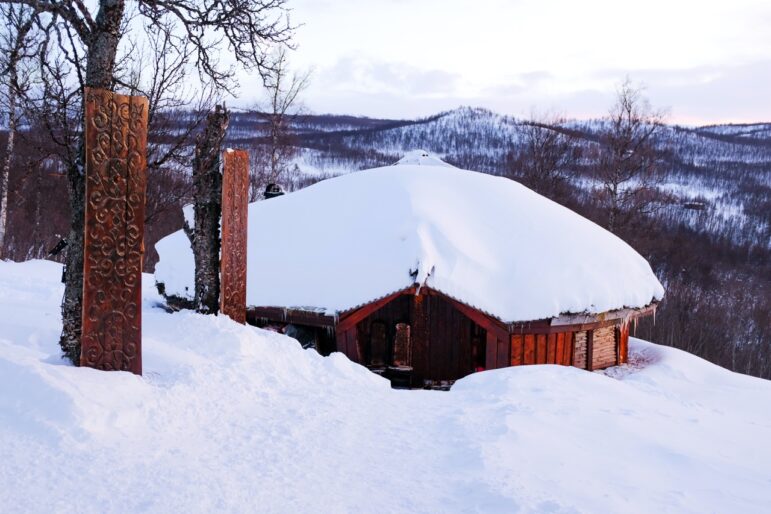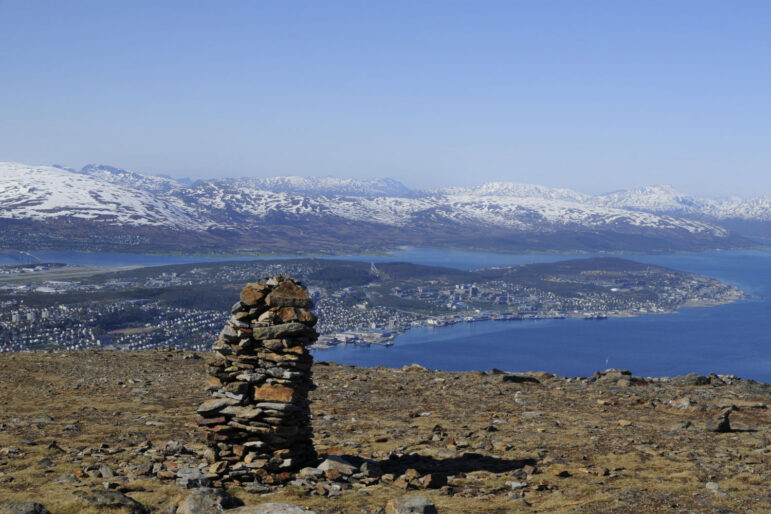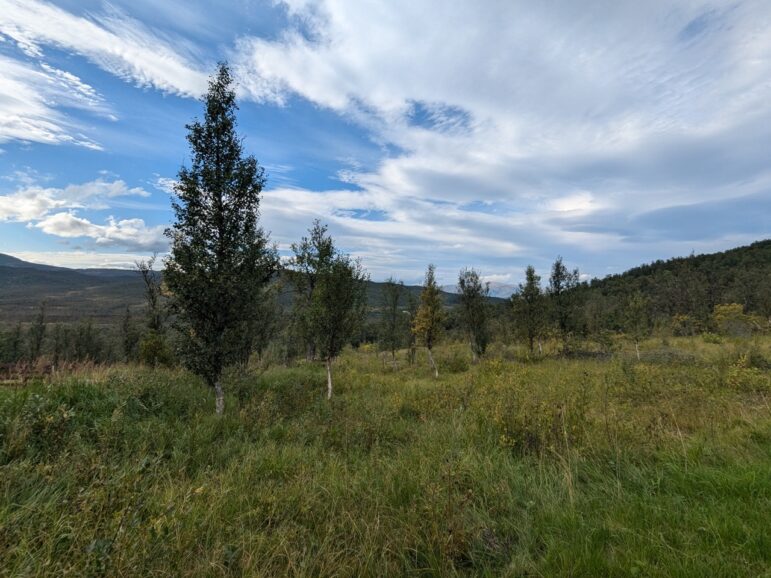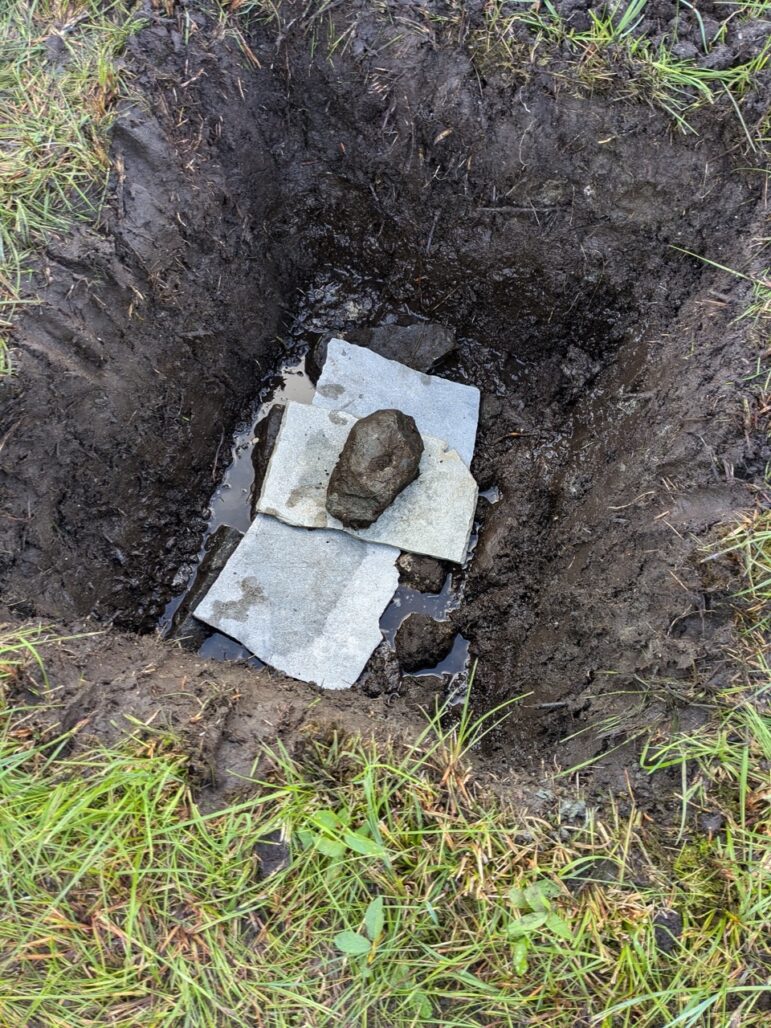
One day this August I picked up my phone and called Jens-Roger.
“Hei Jens-Roger, it’s me, Lyonel, how are you doing? You have a minute?”
“Yeah of course, what is it?”
“You know I told you the other week that I and my family were moving out?”
“Yes, I remember.”
“Well, I was thinking that before we leave for good, we should bury our daughter’s placenta and I thought that, as you have a pretty big property and we all really enjoy your place we could find a spot somewhere there.”
“…”
“What do you think?”
“Yeaaaah, I guess it is possible. Give me some time to think about a spot. I’ll get back to you.”
“Thanks Jens-Roger. Vi høres!”
Ten minutes later, Jens-Roger sent me an MMS showing a grassy patch by the hillside.
“We can put it here, it will be the best spot,” he wrote.
“Cool, that sounds great. My wife and I will be coming on Tuesday then, see you.”
“See you.”
Jens-Roger is a fascinating fellow, a bit strange by some standards, but a great guy nonetheless. I first met him two years prior, when one of the many tourism companies I worked for then asked me to help develop a new, Viking-themed product for the American market. Being married to a (half-)American, and having studied Norse myth in college, I was the man for the occasion. Soon after taking the job, I joined a couple of the higher-ups on a trip to Jens-Roger’s place in a somewhat secluded valley, some distance away from Tromsø.
I had never been to this place myself, but I had hiked the valley before, and vaguely knew of the man, who, I recalled, was known as a somewhat eccentric carpenter living in the woods, a sort of local strange bird (a“byoriginal” as Norwegians say). What I did not know was the extent of his work. To my surprise, Jens-Roger’s property, perched on a hillside overlooking the valley, was made up of no less than half a dozen wooden Viking-age, medieval, and Sámi-inspired wooden buildings.
Upon meeting the man (who, for the occasion, was dressed in a lamellar leather armor he had built himself) and hearing his story, I could not help but become fascinated by the extent of his passion, dedication, and productiveness. Here he was, a semi-hermit Viking carpenter living his best life in the middle of the woods, crafting wonder after wonder. The higher-ups were right; the tourists would eat that up and ask for seconds. I quickly got to work researching and writing a guiding manual for the tour, and soon I started taking people there myself.

One of Jens-Roger’s many Norse-inspired architectural creations. Photo used with courtesy.
After more than a decade of tourism work, this gig was a breath of fresh air: not only did I finally get the chance to do something new, but it combined a beautiful nature excursion with the opportunity to communicate some of what I had learned about Old Norse Religion and the Viking Age. I subsequently led as many of those tours as possible and always had a lot of fun every single time (even on a certain December day when we took an hour to snowshoe through the forest in minus 18 degrees Celsius [0 Fahrenheit] temperatures and a snowstorm.)
Over time I also got to know Jens-Roger fairly well, and I became quite intrigued about his views on religion and spirituality, and the way he presented them to tourists. Most notably, one of the very first things he does whenever I come up the hill with wealthy American cruise tourists is take them to a large stone on the grass, before proceeding to talk about the ancient practice of blót and the numerous Pagan and Heathen weddings that had been held there.
Although Jens-Roger does not call himself a Pagan or a Heathen, his open displays of tolerance and acknowledgment of the Faith always struck me as genuine and heartfelt. This is even more noteworthy considering that he routinely holds Christian weddings and even services for the Norwegian national church on his property.
“In here, you really can feel the power of both the old and the new religion.” He never fails to tell this to the tourists. In many ways, Jens-Roger exemplifies the kind of syncretism that many scholars believe held sway in Scandinavia for a time following nominal conversion.
This aspect of Jens-Roger’s personality and lifestyle was yet another reason I particularly enjoyed working alongside him. True, this was not quite a tour of a modern Heathen hof, but in many ways, this was even more alluring an experience.
As fun as that gig was, I knew pretty much as soon as it started that it would not last. Since Covid, my wife and I had been seriously considering moving out of Tromsø and the Arctic North and getting closer to family, somewhere further south in Scandinavia if possible.
This summer, we finally got the opportunity and seized it. We agreed that we would be leaving for good, and put things in motion to make it happen. Besides the obvious administrative and logistical constraints involved, there was of course an emotional and spiritual aspect to the move that we needed to address.
After all, Tromsø, where I moved aged 19; it’s where I met my (future) wife, who was the one to seriously introduced me to modern Paganism. This is also where I learned English, Norwegian, got my first degree, got my first real jobs – in short, where I experienced adulthood for the first time.
One moment early in our time in Tromsø I remember especially fondly was the 21st of May 2012, the first day of the Midnight Sun. We had borrowed two large, circular sleds from the student office and took the cable car up the mountain to make an offering atop the still-snow-covered peaks. I still recall the crisp invigorating freshness, typical of those Arctic spring days and nights, and the low, amber sun, painting the snow cliffs in deep shades of crimson and orange.

A view of Tromsø from atop the cable car. Photo used with courtesy.
Most of all, I cannot forget how, just ten minutes before the station’s closing time, we realized we might not be able to take the last ride home, so we hitched our sleds one in front of the other, and slid at supersonic speed over the wet snow, blinded by the Midnight Sun.
I kind of wanted to do something similar before we left. Maybe not anything that involved, considering we since then had acquired a kid, multiple jobs, and had much to pack, but still, doing something would be nice, we both agreed.
This is when I remembered that we had kept our daughter’s placenta.
The plan since the beginning had been to bury it somewhere. Judging by how unfazed the hospital nurses looked when we asked if we could take it home, it must be something relatively commonplace in Norway as well.
Still, unlike Norwegians, neither I nor my wife owned any property, nor had any local family members who did. So we never got around to finding a spot for the placenta and left it in the freezer for almost four years.
There was no way we could take that thing with us over the border, we realized, so we had better find a place to bury it. After a short brainstorming session, I proposed Jens-Roger’s place and my better half seemed positive. This is when I made the phone call that opens the present article.
Finally, we got a spot for the placenta, and we could perform a closing ritual of sorts! Now there was nothing left to do but to dig.
When we arrived at the edge of the valley and parked the car, it was a beautifully sunny day. I grabbed the basket containing the metal box where the thawing placenta was being kept and we went on our way.
We walked under the birches and the spruces, crossed the little stream, snatched some berries in the heaths and generally took our time. This might be the last time for a very long time that we would be walking through these woods, so we had better enjoy the moment, we felt.

The hillside by Jens-Roger’s property. Photo used with courtesy.
When we arrived at the hillside, Jens-Roger was there to greet us. Judging by his attire, he had just been stepping out of his workshop but seemed jolly enough to show us the way:
“Here, let me show you!”
He took us toward the hillside, on the other side of the dirt road by the entrance of his property.
“Here!” He gestured to the land around us. “Some years ago I wanted to build a whole stave-church replica a little bit up, and here is where I would have built the wooden stairs leading up to it, but unless I get a ton of unexpected funding, this probably won’t happen, so we can call this your daughter’s stead!”
Jens-Roger then proceeded to hand me a thick, square spade before instructing me to dig about a meter (three feet) deep and across before depositing the placenta. He then proceeded to wish me good luck before retiring to his workshop.
Upon first inspection, the spade was sharp enough, and the shaft the perfect length, but the ground up here is much more humid than expected. Digging even the uppermost layer of soil is not easy and I get both wet and dirty very quickly.
“Darn!” I raged. “This is tough! Do you want to give it a try dear?” I asked my better half, as suavely as possible.
“This was your idea my dear,” she bluntly retorts. “I am happy to just watch.”
I get back to work.
After 10 or so minutes, I have managed to remove the first layer of dirt, divided in nine, almost foot-long pieces of turf.
For the next hour or so, I do nothing but dig deeper, utter curses and get stiffer all over my upper limbs.
After a while, though, my spade meets with, on one hand, larger and heavier rocks, and wetter, muddier soil on the other. It is not quite one meter, but it seems pretty darn impossible to go deeper, so I go ask Jens-Roger whether it would be acceptable, to which he acquiesces. He then takes a decorated drinking horn, pours some of his homemade mead in it and tells me to refresh myself.

The horn of homemade mead. Photo used with courtesy.
I take a gulp of the delicious nectar, but keep a little bit for later. Now is the time for the actual ceremony.
I head back towards the hollow, hand the horn to my wife, and start gathering rocks laying about the turf pile. It does not take me long to get a couple of decent flat stones on the bottom of the hole, so I can finally get to the basket and grab the placenta container.
Thankfully for everyone involved, the bloody, flesh-colored mass had not turned to mush, or remained frozen, but retained its pouch-like shape, which quickly and easily slid down to the stones.
Half as an offering and half thinking of future archeologists, I then cast in two recent coins – one Spanish-minted Euro and one US dollar – before pouring the remaining mead over the whole thing. My wife and I uttered a few words, thanking the spirits of the land for the good times they bequeathed us before I shoveled the remaining turf and stones back into the depression. In five minutes, the hole was covered and we go thank Jens-Roger for his help and hospitality.
There: the deed was done.

The completed ditch, with the placenta covered under some additional rocks. Photo used with courtesy.
As we slowly moseyed down to the car, my wife and I kept talking about the good times we had, the good times we will have, and the ritual itself.
It felt good, we concluded. It felt grounding, and it felt right.
After almost a decade and a half, we managed to leave something behind, not in an unresolved issues kind of way, but as a gift, a rightful restitution, an acknowledgment that, whatever happens, there will always be a part of us up there in the Arctic.
How will this affect us? How will it affect our daughter? No idea. None of us have any gift of second sight I am afraid. Maybe this whole thing will just ever live on as a fun or awkward anecdote, or maybe it will take on other meanings.
As I write those lines, I highly doubt we will ever move back up North, and I don’t even know when we will have the opportunity to visit. I just know that right now, I am nothing but thankful for the time we spent, for all the experiences we got to have there, and all the ways we grew. I can only conclude that, finally, in some ways, I am at peace.
I guess the ritual must have succeeded then?
The Wild Hunt is not responsible for links to external content.
To join a conversation on this post:
Visit our The Wild Hunt subreddit! Point your favorite browser to https://www.reddit.com/r/The_Wild_Hunt_News/, then click “JOIN”. Make sure to click the bell, too, to be notified of new articles posted to our subreddit.
